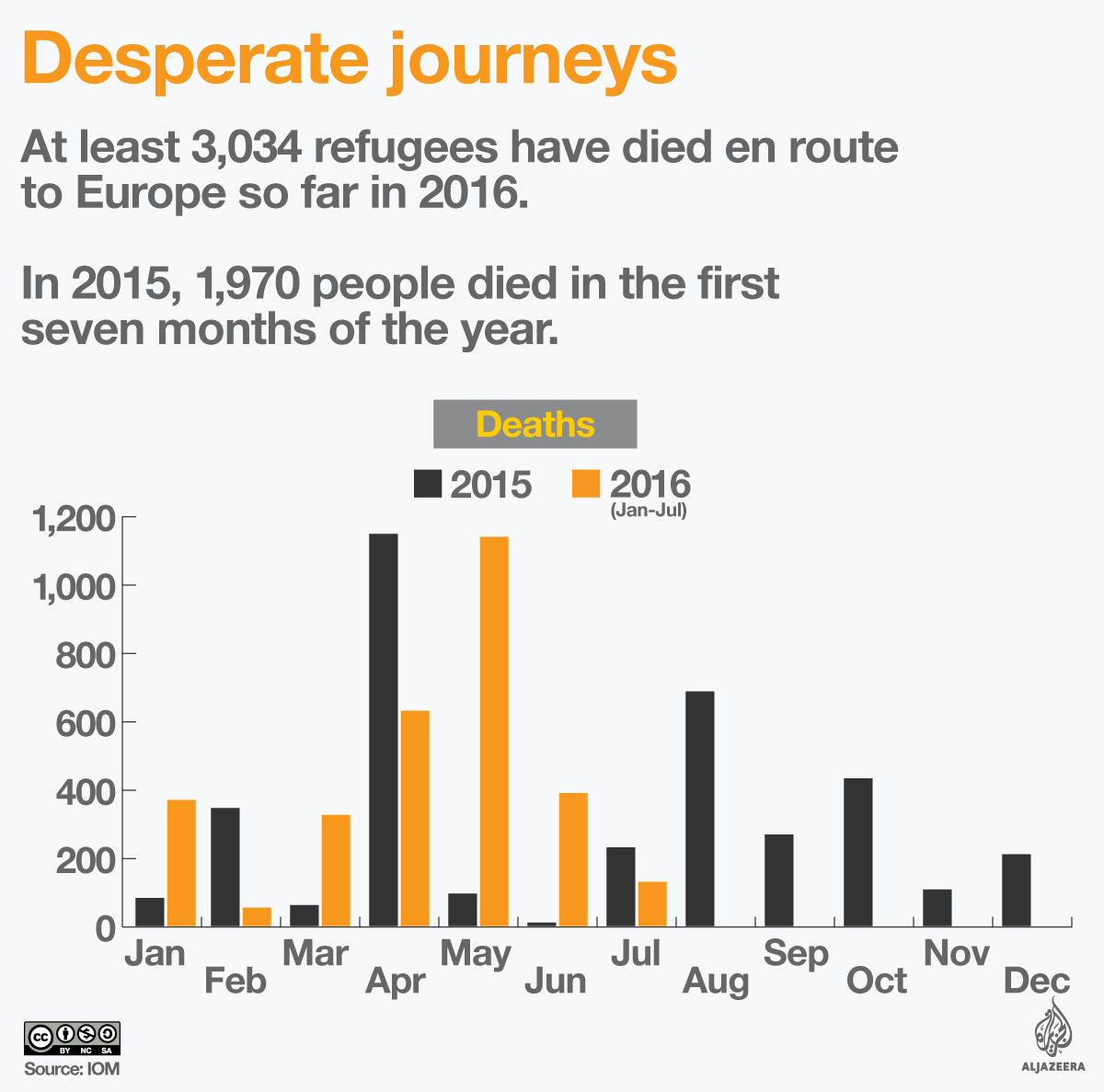Desperate journeys: 3,034 refugees die in seven months
At least 3,034 refugees have died en route to Europe so far in 2016, a sharp increase from last year, says the IOM.

Almost as many Europe-bound asylum seekers and irregular migrants have died on desperate journeys so far this year than in all of 2015, the deadliest year on record for refugees.
At least 3,034 refugees perished on the Mediterranean Sea between January 1 and July 28 of 2016, compared with 1,970 in almost the same period a year earlier – an increase of 54 percent, according to the International Organization for Migration (IOM).
Keep reading
list of 4 itemsIranian man loses bid to be freed from Australian immigration detention
Beyond borders: Migrants online
Tunis police raid sees refugees abandoned near the border with Algeria
In all of 2015, at least 3,771 refugees lost their lives crossing the Mediterranean.
We are well on track to exceeding the total number of known deaths that occurred in 2015
Many believe that given the alarming figures, 2016 will set a new record for refugee deaths, as calls by human rights organisations to provide safer passages go largely ignored.
“We are well on track to exceeding the total number of known deaths that occurred in 2015,” Niels Frenzen, director of the Immigration Clinic at USC Gould School of Law, told Al Jazeera.
“I don’t expect the crisis, which is many different crises, to be resolved any time soon … Harsher policies that focus more on border control and less on humanitarian protection are likely.”

The news of more refugees dying as they attempt to cross in unsafe and overloaded boats comes as much of the West questions its asylum and immigration policies.
“The far right in Europe and in the US is having an effect on the debate about refugee protection and it will likely result in harsher policies,” said Frenzen. “The hard line taken by Hungary and other Eastern EU countries was a significant reason the EU ended up negotiating the EU-Turkey agreement.”
‘A stain on Europe’s values’
Far fewer people died – 383 – in 2016 on the eastern Mediterranean route between Turkey and Greece compared to previous years. Arrivals have slowed to a trickle since the EU struck a deal with Ankara to curb the flow. At least 2,606 people died en route to Italy from Libya, the IOM said.
“This is not just a stain on Europe’s presumed ‘values’, but also a threat to the stability of the countries where the refugees and the migrants are pushed back,” Mattia Toaldo, a fellow at the European Council on Foreign Relations (ECFR), told Al Jazeera.
“Most countries, including big ones like France and the UK, have almost completely insulated themselves from the crisis. Europe’s borders in the Balkans have been shut, tens of thousands of people are stranded in Greece and many more are locked in Syria because Turkey has no more interest in letting them in.”
READ MORE: Refugees in Greece – ‘We are living in a prison here’
Most departing Libya by sea to Europe are from Africa. Syrians have all but stopped using the route to enter Europe due to increased dangers.
| DESPERATE JOURNEYS |
Source: IOM
|
In a recent report, Doctors Without Borders (MSF) likened smuggling conditions in Libya to “slave trading”.
“In a practice similar to slavery, many people have described how they were forcibly taken and held for the purpose of forced labour,” MSF said.
“Shuttled between middlemen and ‘brokers’, locked up at night in detention-style conditions in private homes or warehouses, men are forced to work on construction sites or farms during the day, often for months at a time, until they have paid their way out. Many women report being kept in captivity as domestic servants or forced into prostitution.”
Poor treatment in Libya is “one of the main push factors for migrations in this route,” said the ECFR’s Toaldo. “Libya used to be mostly a destination country, but now, because it has become such an inferno, people try to flee to Europe as much as they can while an increasing number asks the IOM for voluntary repatriation to their home country.”
Trafficking concerns
According to the Italian ministry of interior, at least 3,529 women form Nigeria have arrived in smuggling boats so far in 2016, compared to 1,491 in the same period last year. Nigerians are among the top nationalities departing Libya. At least 80 percent of Nigerian girls were victims of trafficking, the IOM said.
“They are lured into enslavement and subjected to voodoo rituals to brainwash them into accepting their fate,” said IOM Rome spokesperson Flavio Di Giacomo. “They believe that any attempt to escape or rebel against their traffickers will cause harm to them and their families.”
READ MORE: Rescued refugees detail abuse in Libya
The USC’s Franzen said smuggling groups sometimes cooperate with one another.
“Sometimes that cooperation is more benign than at other times, for example, passing a person from one group to another as part of a package deal. Sometimes smuggling groups will fight with one another, kidnap migrants from another smuggling operation, and charge a new price to the migrant or the family.”
More than one million refugees arrived in Europe last year. At least 251,557 have arrived so far this year, an increase of 14 percent from last year, according to the IOM.
Follow Anealla Safdar on Twitter: @anealla